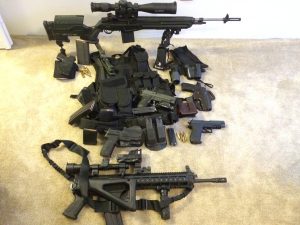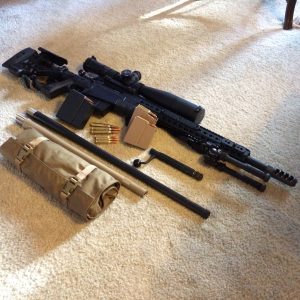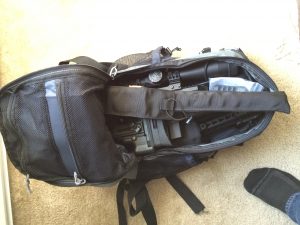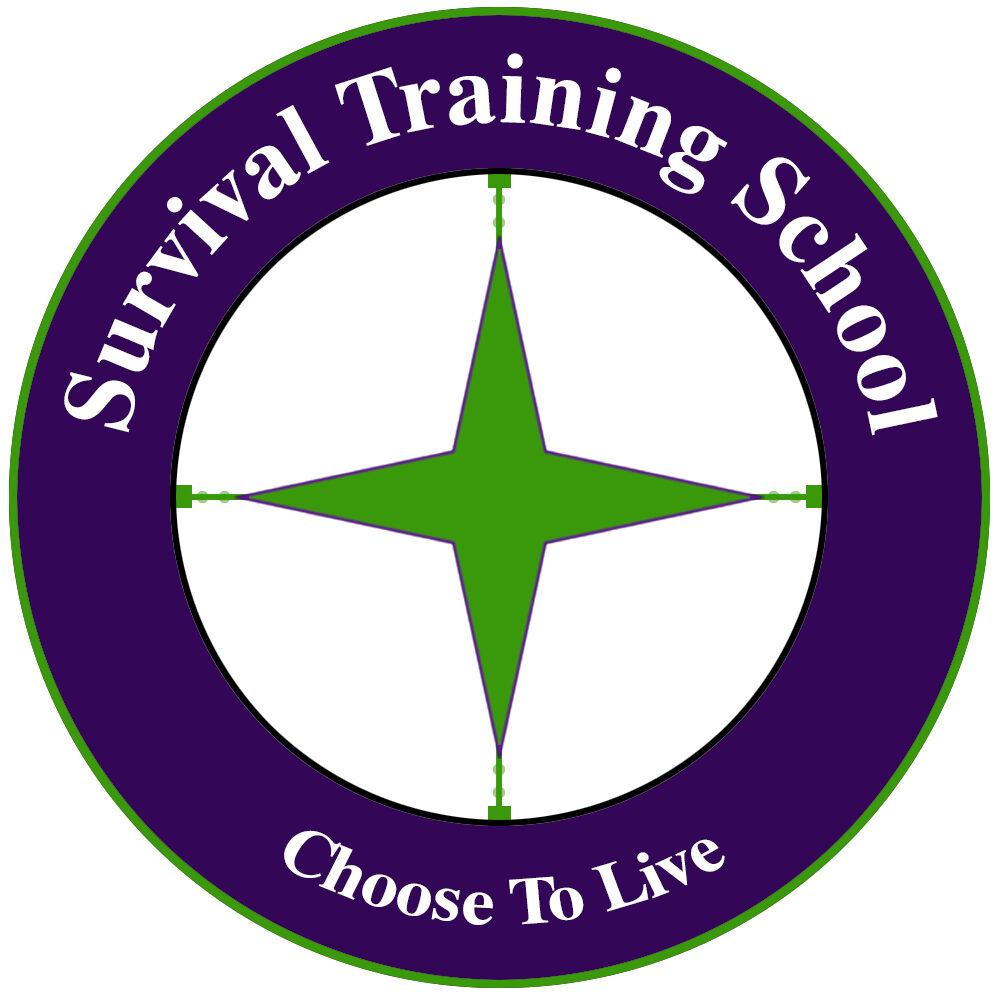I have been shooting since I was 5-years old. My favorite time though was when I could shoot all day long with the U.S. Army Rifle Team. We’d be up at O’dark thirty and off to the range after chow. The first 7.62 rounds from our venerable M14’s would zip down range at 8:00 am until noon when we broke for lunch and back at it again from 1:00-5:00pm. After an hour for mess, we were required to perform 2 hours of dry-fire practice. All of this was done with iron sites, aperture sights as is common in the military. We were never allowed to use glass. Shooting up to 600 yards and occasionally allowed to shoot to 1,000 yards with them was probably the most fun time in my life with firearms. All day long shooting gives you an appreciation for skill sets and weaponry selection. And, believe it or not, the principles are required for the black rifle as well, after all, it’s not a shotgun.
It was all about the challenge and I took it personal. Before shooting with the team, 300 to 400 yards with the black rifle was all we attempted and, with a 5.56, that was a challenge at 400 yards. Why? At 400 yards, using 1 in 10 twists the black rifle 5.56 round began to tumble and lose accuracy. But, it was fun. Even more fun after the rifle team was pushing the black rifle out to 600-700 yards thanks to the 1 in 7-inch twist developed by the Swiss. Yes, it can be done with the proper twist. But, wind creates havoc for the little guy hence, my love for the 7.62 and 338 Lapua.
If you’re any kind of a decent shot, I can coach you to better heights. If you’re good, you can push minimally, the round out 40{59cf1eb859f5f57db0bf1c6f9a1bca4110a5bfaab968c22e984832014807c6b3} past what most term the effective range. This is where the round drops from supersonic to transonic speed. It’s not a big deal really, although many claims it as such. The record books are full of shots taken way past a weapons effective range – it’s all about basic skills. You too can do this, but it requires learning fundamentals very well. Watching someone else shoot, or a video of how it’s done is simply ineffective. Come to the Birmingham course and I’ll show you how. And, come with all your questions. Can you read the range out to 600 yards or so with a basic cross-hair scope absent of mil-dots? Snipers during Vietnam and earlier eras could. Fundamentals are key when technology breaks down.
While many believe the shooting world has gone long-range crazy, it’s a fact that with today’s technology, someone with minimal skill sets can shoot up to 600 yards quite accurately. But remember, if your Horus or other type reticle fails, you need fundamentals and, with them, you can still shoot to great distances. Try looking down the irons at a 30-inch bulls-eye target at 600 yards. It literally looks like a needle pointing back at you.
Whether shooing whitetail deer, wild hogs, mountain rams, or soft-target interdiction, I’ll show you the basics of how to shoot out to 2,000 plus yards if you have the right equipment. What’s that, you think you do, well, let’s check it out. Believe it or not, in all my years of shooting I have not found the man or woman that can out shoot his or her equipment if that equipment is half-way decent. Perhaps you’re the exception.
Equipment:
Caliber: Choose a caliber that’s right for you. Don’t worry about what the pundits say. If you’re worried about survival, choose calibers the military uses so there’s always at least one way to get ammo for them, i.e., 5.56 mm (.223), 7.62 x 51 mm (.308), .300 Win. Mag., .338 Lapua Mag., 9mm, and .45 cal. (the latter two are for pistol selections). Trust me, when the stores are always closed, you’ll be glad you made such choices.
Your selection needs to be something that feels good in your hands, pistol or rifle, and that lines up sight-wise almost automatically. It needs to feel comfortable. Personally, I like heavier weapons that aren’t what I refer to as ‘combat Tupperware.’
What is the general range you’ll be shooting at? Make your selection based on that. Beware that if you migrate to more open territory for survival purposes, the range of target acquisition can increase considerably. So, think ahead and consider this change in your overall preparedness and strategy.
Remember that at longer ranges, wind plays fun with ballistics and light-weight rounds. So, if you’re planning on shooting at 700 plus yards, 5.56 type and panty-waist rounds are not going to cut it. Step up to 30 calibers. In my opinion while I like the 50 calibers, it truly is a crew served weapon and not one to carry long distances with lots of rounds that are far heavier than the 30 caliber rounds.
It’s all about repeat-ability. If you make an accurate shot at 1,000 yards then, you should be able to consistently repeat it. If you cannot, you’re guessing and weak in fundamentals. Let me help you.
Optics are where the rubber meets the road. You do not need to buy the very best, but you need something reliable that you can adjust back and forth without loss of accuracy. It’s something we discuss at length with black rifles in the course. Why? Because you either have essentially only an entry rifle or, you have something that can take out a target blocks away with accuracy. What do you want to do or can you do? Good optics will make it easier and more likely. Can you take out a target with your black rifle at 500-600 yards, well, you should be able to.
Training constantly helps, not just at the range, but dry-fire, tactical maneuvers, reading wind, distance, entry processes, etc. I always make a bet with my students, if I cannot improve your skill sets in a 5-minute session, well, here’s a $25 Starbucks card. It’s about technique, technique, technique. Beethoven didn’t create any of his symphonies in 5 minutes and he didn’t learn to play the piano that way either. Let me set you on a good path to do what you want and need to do.
Do you have the right mind-set? If not, success can be very elusive. The Birmingham course will dwell on this too and help you develop it. Why is this important? Because problems on the firing line are almost never the fault of the equipment, but the user! If you miss, it wasn’t the equipment’s fault.
Basics, techniques, fundamentals are the major points for training and success. Are you aware of what these should be? Let me us help you overcome any deficiencies in these areas. I could go on and on, but you get the point. And, one final note: imagine a sniper, now imagine a sniper with 30 years experience and a PhD in physics behind the optics. Think you’ll notice a difference?
The photo below shows an assortment of some of my personal gear. Top is an M1A with Krieger National Match Barrel, J-Allen Enterprise stock, and U.S. Optics 3.2 x 17 TPAL with Barrett Grid Reticle with blue low-light settings (I’ve shot accurately to 1650 yards with it, i.e., sub MOA). Bottom is my black rifle, one of several, but my favorite, set up for entry and urban sniper – a Sig 556 SWAT. The pistols are mostly Sig 226s in 9mm.

For extreme long range, my personal Accuracy International .338 Lapua, with 20 and 27 inch barrels (black) and also .308 caliber (tan components); scope is NightForce Beast 5×25 MilR reticle. It can reach out to, well, I’ll tell you in person.

The rifle will also fit into a small backpack with the 20 inch barrel and has repeatable accuracy, less than 1/2 MOA.

See you at STS!

